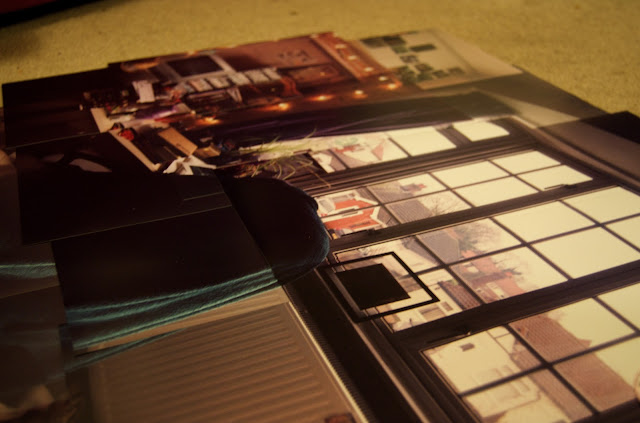So here, finally, is the finished piece. And here is my long, probably rambling, evaluation of the project.

So, right from the beginning of this project I knew I wanted to incorporate printed images with sewing techniques, to play on the idea of 'stitching', now recognised in the world of photography as a Photoshop term. I knew I had to get this idea out there, and so did some research into a photographer that I had seen in the past, but never particularly acknowledged, Maurizio Anzeri, who takes found images and embroiders meticulously detailed designs into them to create beautiful, unique artefacts. Now I knew my sewing skills were not as well practised as his, so I would have to simplify this idea greatly. Whilst researching for my Major Practical Project I remembered a piece that a friend of mine, Lennie Gotterson, had created for her foundation degree in art and design - a long, detailed, line drawing of her street of houses. Combining the two ideas I thought about creating a panorama of my street, but using analogue, hand printed images and stitching them together. Over a few weeks, and with the suggestion that I should make the piece more personal, I settled on the idea of shooting my bedroom.
Here are some more images of the final piece I will be submitting:
On the whole, I am very happy with how the piece has turned out. It's completely different to anything I have done before, and making it presented a whole load of new challenges. However, my main aims for the piece are as follows:
- Create a panorama style image, using analogue processes and stitching the prints together with thread.
- Allow the viewer to get a relatively detailed look into a private space of mine, make it large enough to be able to see the things in the room quite clearly.
- NOT to make it perfectly slick (although I was never really in any danger of this happening)
- Invest something personal to myself in the piece.
I do feel like I have achieved what I set out to do. I didn't want it to be perfectly slick and seamless, because otherwise I may as well have just made a digital panorama. My favourite bits about the piece are where items are repeated, or the perspective is slightly skewed. Realising this came from looking at David Hockey's photographic collages, where people can feature in the image multiple times as they have moved, but the meaning and general impression of the scene remain.
I also think I have succeeded in investing the thread with some meaning and personality. If I were to exhibit I would have to make sure that it was made clear to the viewer that the thread is actually the wool from a cardigan I wore as a toddler, and have long since grown out of, and that this reflects the fact that I've also metaphorically grown out of my bedroom at home. Here is an area where I feel I could have made it more obvious, perhaps featuring a picture of me as a child wearing the cardigan somewhere subtly in the image.
The most difficult thing I found in this project was the printing. I had to do hand prints of around 70 images, ensuring that they were largely the same tone and exposure so that the piece would be coherent. For the most part, I think I have achieved this. However, there are some bits where I think I should have made some reprints:
In the first image, the image of the top of the door/border is a different tone to the one immediatly to it left. In the second the bottom image is clearly darker and in the third there are two images that have a slight green cast, contrasting to the slight magenta one of the rest of the images.
Overall, I really feel I have invested myself in this project, more so than I have done in the past. To me, the more time and emotion in a personal project like this, the better. I like that people can get a bit of an impression of my character from looking at my ridiculously-filled-with-stuff bedroom - I have built up this massive collection of items and stored them in this room for almost 21 years and I like that people could get up close and inspect almost every inch of it. So on the whole, aside from the few bits I have mentioned, I do feel this project has been a success.

















































